PwC Value Framework: M&S Performance Information Analysis Report
VerifiedAdded on 2023/04/26
|26
|6469
|320
Report
AI Summary
This report presents an evaluation of Marks & Spencer's (M&S) performance information, assessed through the PWC value framework. The analysis examines various elements, including objectives, strategies, business models, governance, risk management, remuneration, resources, financial and physical assets, customer relations, and innovation. The report highlights strengths in areas like objectives and risk management, as well as weaknesses in customer relations and innovation. The assessment covers the comprehensiveness and accessibility of information within M&S's annual reports, providing a comprehensive view of the company's performance. The report also touches upon the business model, corporate governance, and financial aspects of the company, drawing on the 2018 annual report to illustrate its findings. The report concludes with an overview of performance across operational, economic, social, environmental, and segmental aspects, with an emphasis on the quality of information and its impact on decision-making.
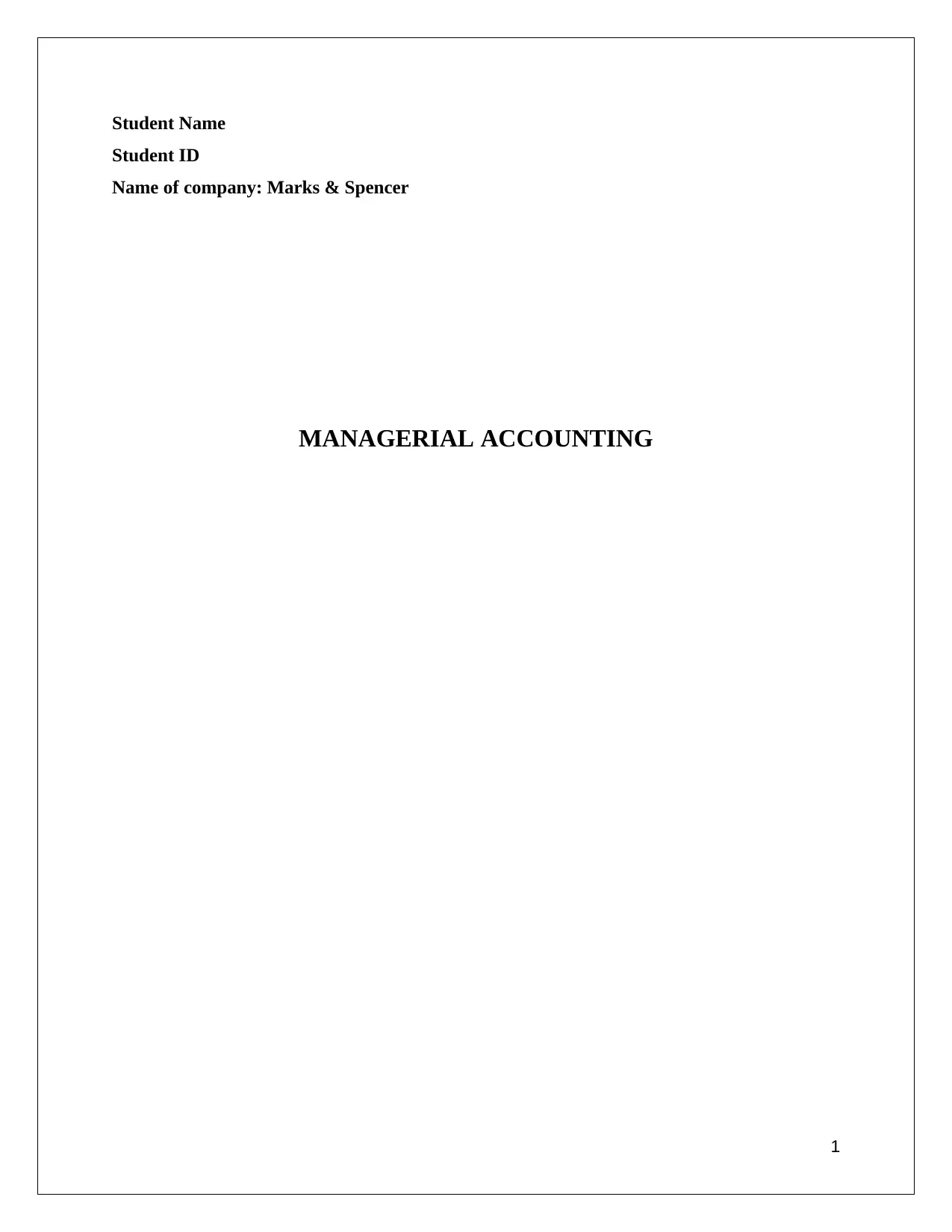
Student Name
Student ID
Name of company: Marks & Spencer
MANAGERIAL ACCOUNTING
1
Student ID
Name of company: Marks & Spencer
MANAGERIAL ACCOUNTING
1
Paraphrase This Document
Need a fresh take? Get an instant paraphrase of this document with our AI Paraphraser
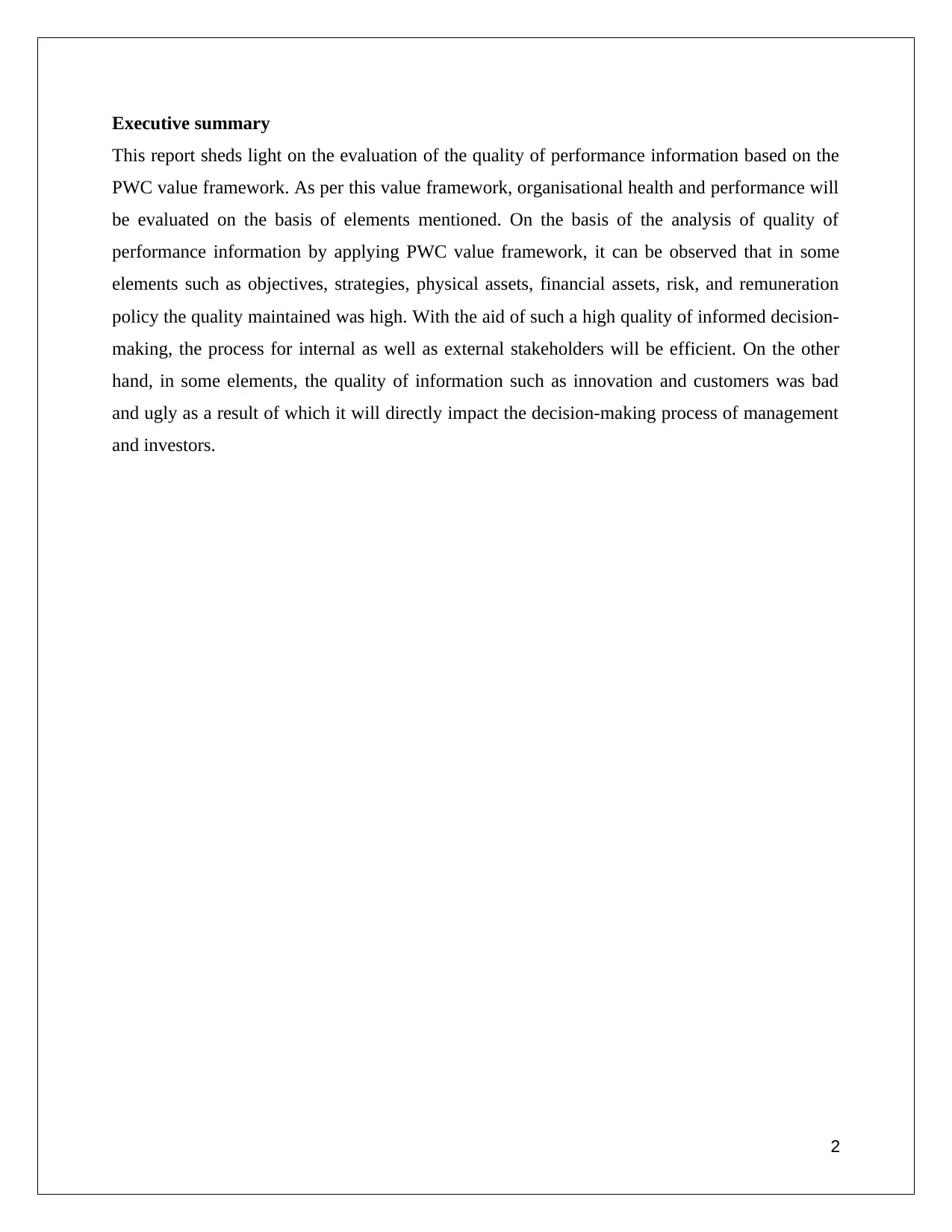
Executive summary
This report sheds light on the evaluation of the quality of performance information based on the
PWC value framework. As per this value framework, organisational health and performance will
be evaluated on the basis of elements mentioned. On the basis of the analysis of quality of
performance information by applying PWC value framework, it can be observed that in some
elements such as objectives, strategies, physical assets, financial assets, risk, and remuneration
policy the quality maintained was high. With the aid of such a high quality of informed decision-
making, the process for internal as well as external stakeholders will be efficient. On the other
hand, in some elements, the quality of information such as innovation and customers was bad
and ugly as a result of which it will directly impact the decision-making process of management
and investors.
2
This report sheds light on the evaluation of the quality of performance information based on the
PWC value framework. As per this value framework, organisational health and performance will
be evaluated on the basis of elements mentioned. On the basis of the analysis of quality of
performance information by applying PWC value framework, it can be observed that in some
elements such as objectives, strategies, physical assets, financial assets, risk, and remuneration
policy the quality maintained was high. With the aid of such a high quality of informed decision-
making, the process for internal as well as external stakeholders will be efficient. On the other
hand, in some elements, the quality of information such as innovation and customers was bad
and ugly as a result of which it will directly impact the decision-making process of management
and investors.
2
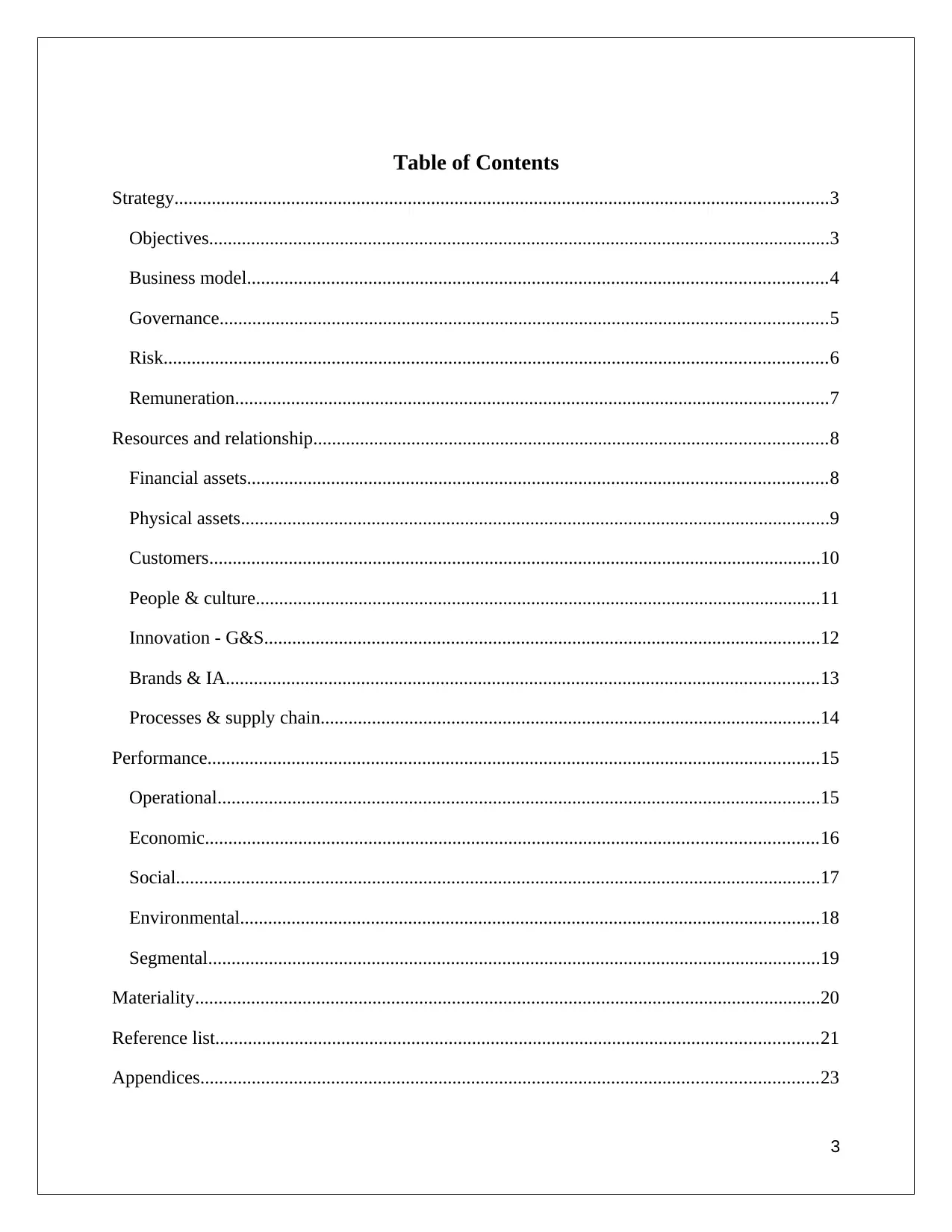
Table of Contents
Strategy............................................................................................................................................3
Objectives.....................................................................................................................................3
Business model............................................................................................................................4
Governance..................................................................................................................................5
Risk..............................................................................................................................................6
Remuneration...............................................................................................................................7
Resources and relationship..............................................................................................................8
Financial assets............................................................................................................................8
Physical assets..............................................................................................................................9
Customers...................................................................................................................................10
People & culture.........................................................................................................................11
Innovation - G&S.......................................................................................................................12
Brands & IA...............................................................................................................................13
Processes & supply chain...........................................................................................................14
Performance...................................................................................................................................15
Operational.................................................................................................................................15
Economic...................................................................................................................................16
Social..........................................................................................................................................17
Environmental............................................................................................................................18
Segmental...................................................................................................................................19
Materiality......................................................................................................................................20
Reference list.................................................................................................................................21
Appendices....................................................................................................................................23
3
Strategy............................................................................................................................................3
Objectives.....................................................................................................................................3
Business model............................................................................................................................4
Governance..................................................................................................................................5
Risk..............................................................................................................................................6
Remuneration...............................................................................................................................7
Resources and relationship..............................................................................................................8
Financial assets............................................................................................................................8
Physical assets..............................................................................................................................9
Customers...................................................................................................................................10
People & culture.........................................................................................................................11
Innovation - G&S.......................................................................................................................12
Brands & IA...............................................................................................................................13
Processes & supply chain...........................................................................................................14
Performance...................................................................................................................................15
Operational.................................................................................................................................15
Economic...................................................................................................................................16
Social..........................................................................................................................................17
Environmental............................................................................................................................18
Segmental...................................................................................................................................19
Materiality......................................................................................................................................20
Reference list.................................................................................................................................21
Appendices....................................................................................................................................23
3
⊘ This is a preview!⊘
Do you want full access?
Subscribe today to unlock all pages.

Trusted by 1+ million students worldwide
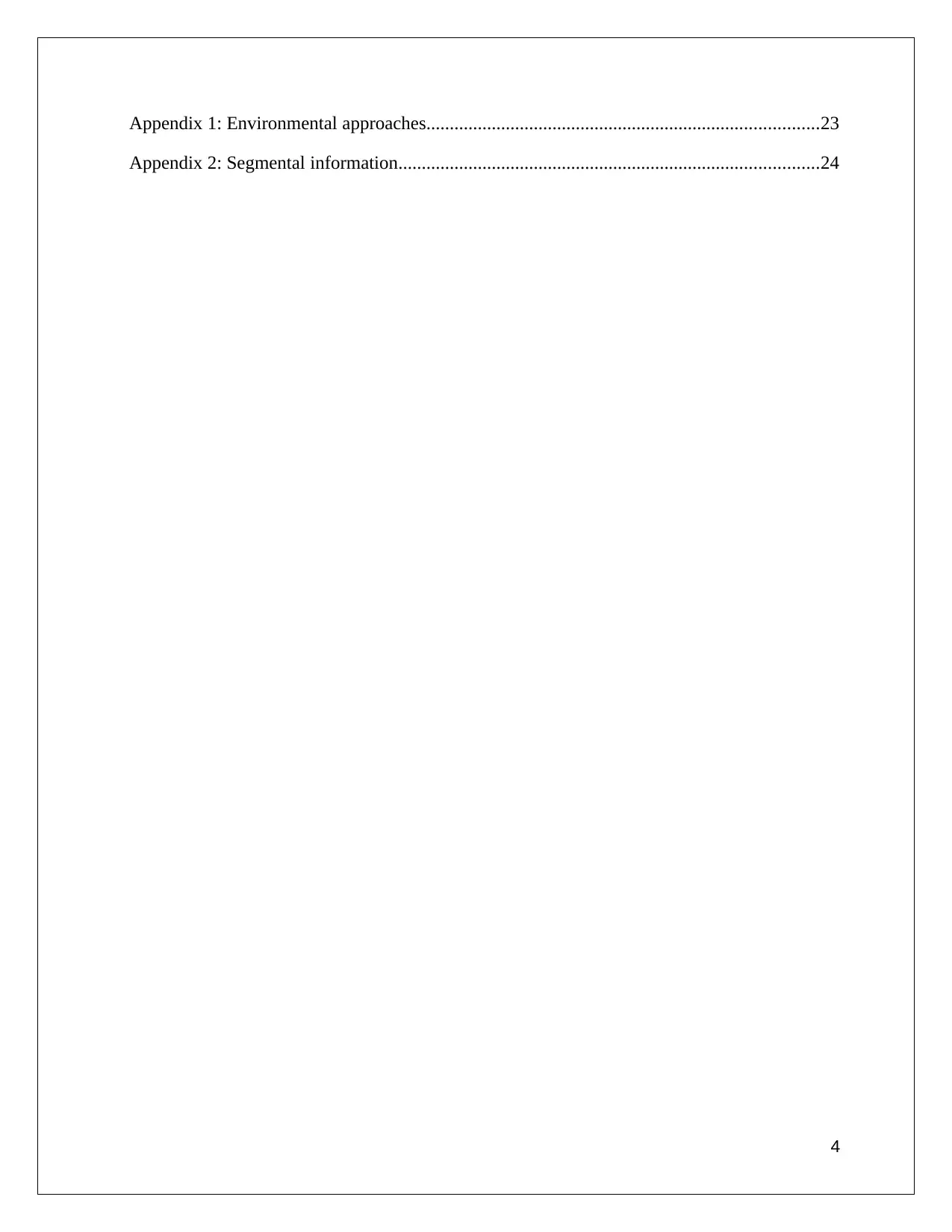
Appendix 1: Environmental approaches....................................................................................23
Appendix 2: Segmental information..........................................................................................24
4
Appendix 2: Segmental information..........................................................................................24
4
Paraphrase This Document
Need a fresh take? Get an instant paraphrase of this document with our AI Paraphraser
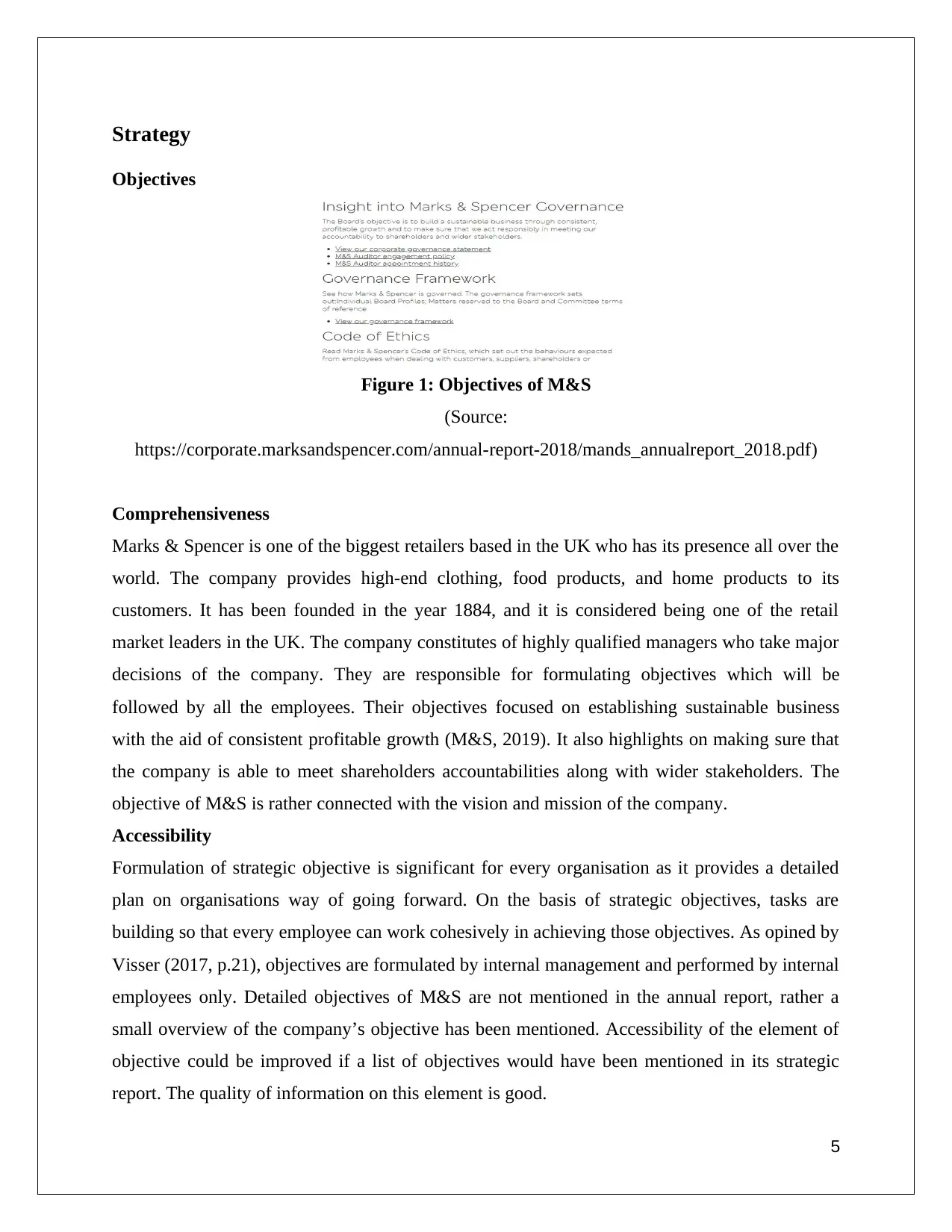
Strategy
Objectives
Figure 1: Objectives of M&S
(Source:
https://corporate.marksandspencer.com/annual-report-2018/mands_annualreport_2018.pdf)
Comprehensiveness
Marks & Spencer is one of the biggest retailers based in the UK who has its presence all over the
world. The company provides high-end clothing, food products, and home products to its
customers. It has been founded in the year 1884, and it is considered being one of the retail
market leaders in the UK. The company constitutes of highly qualified managers who take major
decisions of the company. They are responsible for formulating objectives which will be
followed by all the employees. Their objectives focused on establishing sustainable business
with the aid of consistent profitable growth (M&S, 2019). It also highlights on making sure that
the company is able to meet shareholders accountabilities along with wider stakeholders. The
objective of M&S is rather connected with the vision and mission of the company.
Accessibility
Formulation of strategic objective is significant for every organisation as it provides a detailed
plan on organisations way of going forward. On the basis of strategic objectives, tasks are
building so that every employee can work cohesively in achieving those objectives. As opined by
Visser (2017, p.21), objectives are formulated by internal management and performed by internal
employees only. Detailed objectives of M&S are not mentioned in the annual report, rather a
small overview of the company’s objective has been mentioned. Accessibility of the element of
objective could be improved if a list of objectives would have been mentioned in its strategic
report. The quality of information on this element is good.
5
Objectives
Figure 1: Objectives of M&S
(Source:
https://corporate.marksandspencer.com/annual-report-2018/mands_annualreport_2018.pdf)
Comprehensiveness
Marks & Spencer is one of the biggest retailers based in the UK who has its presence all over the
world. The company provides high-end clothing, food products, and home products to its
customers. It has been founded in the year 1884, and it is considered being one of the retail
market leaders in the UK. The company constitutes of highly qualified managers who take major
decisions of the company. They are responsible for formulating objectives which will be
followed by all the employees. Their objectives focused on establishing sustainable business
with the aid of consistent profitable growth (M&S, 2019). It also highlights on making sure that
the company is able to meet shareholders accountabilities along with wider stakeholders. The
objective of M&S is rather connected with the vision and mission of the company.
Accessibility
Formulation of strategic objective is significant for every organisation as it provides a detailed
plan on organisations way of going forward. On the basis of strategic objectives, tasks are
building so that every employee can work cohesively in achieving those objectives. As opined by
Visser (2017, p.21), objectives are formulated by internal management and performed by internal
employees only. Detailed objectives of M&S are not mentioned in the annual report, rather a
small overview of the company’s objective has been mentioned. Accessibility of the element of
objective could be improved if a list of objectives would have been mentioned in its strategic
report. The quality of information on this element is good.
5
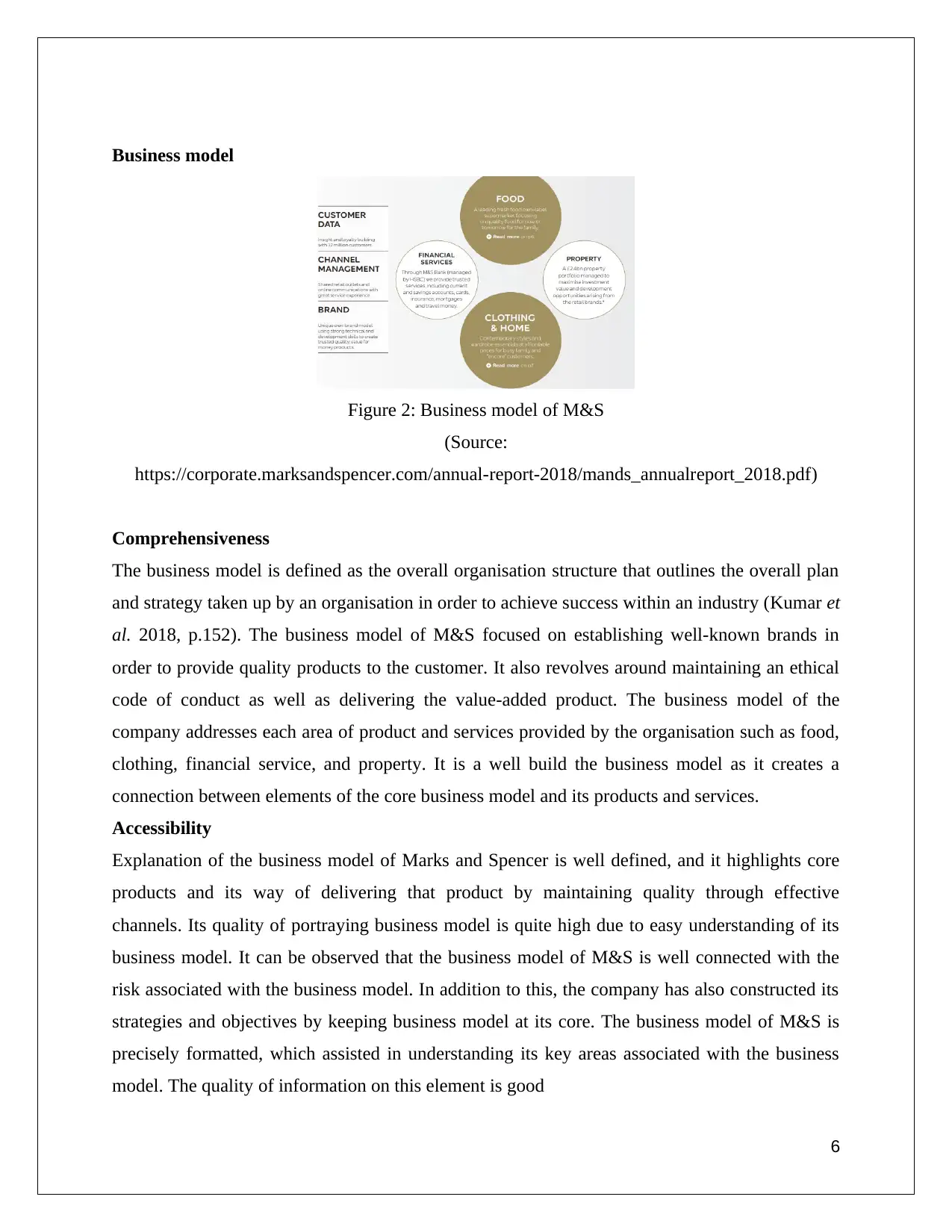
Business model
Figure 2: Business model of M&S
(Source:
https://corporate.marksandspencer.com/annual-report-2018/mands_annualreport_2018.pdf)
Comprehensiveness
The business model is defined as the overall organisation structure that outlines the overall plan
and strategy taken up by an organisation in order to achieve success within an industry (Kumar et
al. 2018, p.152). The business model of M&S focused on establishing well-known brands in
order to provide quality products to the customer. It also revolves around maintaining an ethical
code of conduct as well as delivering the value-added product. The business model of the
company addresses each area of product and services provided by the organisation such as food,
clothing, financial service, and property. It is a well build the business model as it creates a
connection between elements of the core business model and its products and services.
Accessibility
Explanation of the business model of Marks and Spencer is well defined, and it highlights core
products and its way of delivering that product by maintaining quality through effective
channels. Its quality of portraying business model is quite high due to easy understanding of its
business model. It can be observed that the business model of M&S is well connected with the
risk associated with the business model. In addition to this, the company has also constructed its
strategies and objectives by keeping business model at its core. The business model of M&S is
precisely formatted, which assisted in understanding its key areas associated with the business
model. The quality of information on this element is good
6
Figure 2: Business model of M&S
(Source:
https://corporate.marksandspencer.com/annual-report-2018/mands_annualreport_2018.pdf)
Comprehensiveness
The business model is defined as the overall organisation structure that outlines the overall plan
and strategy taken up by an organisation in order to achieve success within an industry (Kumar et
al. 2018, p.152). The business model of M&S focused on establishing well-known brands in
order to provide quality products to the customer. It also revolves around maintaining an ethical
code of conduct as well as delivering the value-added product. The business model of the
company addresses each area of product and services provided by the organisation such as food,
clothing, financial service, and property. It is a well build the business model as it creates a
connection between elements of the core business model and its products and services.
Accessibility
Explanation of the business model of Marks and Spencer is well defined, and it highlights core
products and its way of delivering that product by maintaining quality through effective
channels. Its quality of portraying business model is quite high due to easy understanding of its
business model. It can be observed that the business model of M&S is well connected with the
risk associated with the business model. In addition to this, the company has also constructed its
strategies and objectives by keeping business model at its core. The business model of M&S is
precisely formatted, which assisted in understanding its key areas associated with the business
model. The quality of information on this element is good
6
⊘ This is a preview!⊘
Do you want full access?
Subscribe today to unlock all pages.

Trusted by 1+ million students worldwide
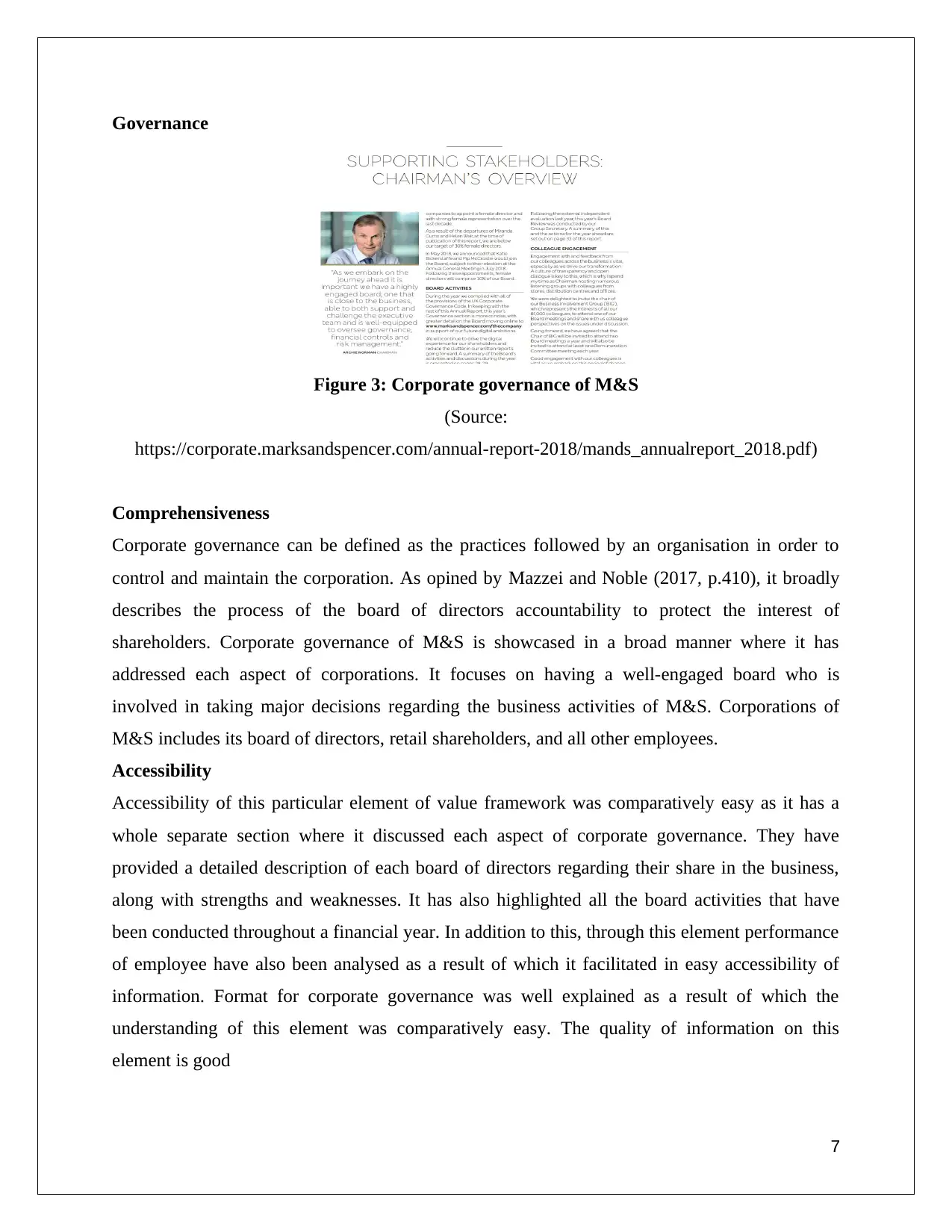
Governance
Figure 3: Corporate governance of M&S
(Source:
https://corporate.marksandspencer.com/annual-report-2018/mands_annualreport_2018.pdf)
Comprehensiveness
Corporate governance can be defined as the practices followed by an organisation in order to
control and maintain the corporation. As opined by Mazzei and Noble (2017, p.410), it broadly
describes the process of the board of directors accountability to protect the interest of
shareholders. Corporate governance of M&S is showcased in a broad manner where it has
addressed each aspect of corporations. It focuses on having a well-engaged board who is
involved in taking major decisions regarding the business activities of M&S. Corporations of
M&S includes its board of directors, retail shareholders, and all other employees.
Accessibility
Accessibility of this particular element of value framework was comparatively easy as it has a
whole separate section where it discussed each aspect of corporate governance. They have
provided a detailed description of each board of directors regarding their share in the business,
along with strengths and weaknesses. It has also highlighted all the board activities that have
been conducted throughout a financial year. In addition to this, through this element performance
of employee have also been analysed as a result of which it facilitated in easy accessibility of
information. Format for corporate governance was well explained as a result of which the
understanding of this element was comparatively easy. The quality of information on this
element is good
7
Figure 3: Corporate governance of M&S
(Source:
https://corporate.marksandspencer.com/annual-report-2018/mands_annualreport_2018.pdf)
Comprehensiveness
Corporate governance can be defined as the practices followed by an organisation in order to
control and maintain the corporation. As opined by Mazzei and Noble (2017, p.410), it broadly
describes the process of the board of directors accountability to protect the interest of
shareholders. Corporate governance of M&S is showcased in a broad manner where it has
addressed each aspect of corporations. It focuses on having a well-engaged board who is
involved in taking major decisions regarding the business activities of M&S. Corporations of
M&S includes its board of directors, retail shareholders, and all other employees.
Accessibility
Accessibility of this particular element of value framework was comparatively easy as it has a
whole separate section where it discussed each aspect of corporate governance. They have
provided a detailed description of each board of directors regarding their share in the business,
along with strengths and weaknesses. It has also highlighted all the board activities that have
been conducted throughout a financial year. In addition to this, through this element performance
of employee have also been analysed as a result of which it facilitated in easy accessibility of
information. Format for corporate governance was well explained as a result of which the
understanding of this element was comparatively easy. The quality of information on this
element is good
7
Paraphrase This Document
Need a fresh take? Get an instant paraphrase of this document with our AI Paraphraser
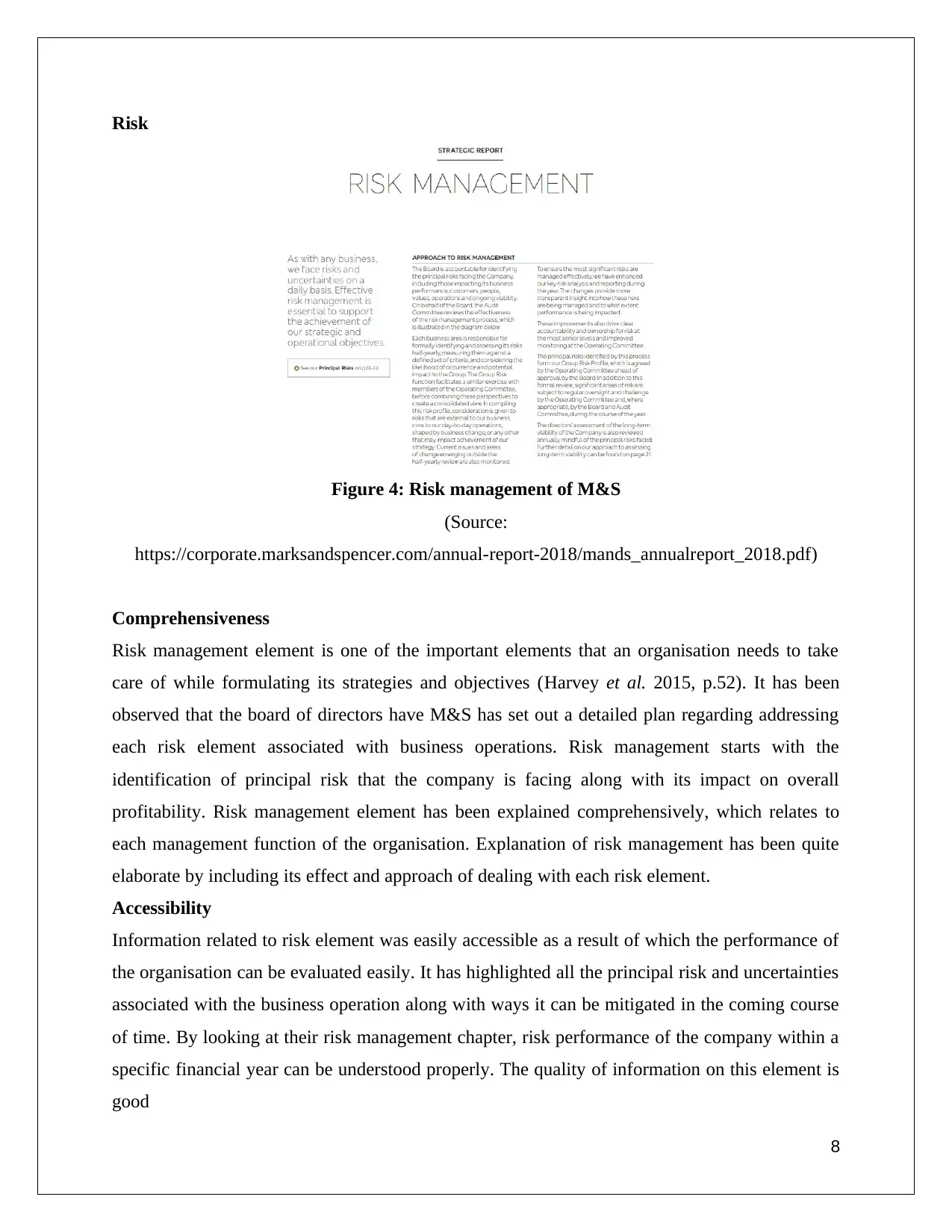
Risk
Figure 4: Risk management of M&S
(Source:
https://corporate.marksandspencer.com/annual-report-2018/mands_annualreport_2018.pdf)
Comprehensiveness
Risk management element is one of the important elements that an organisation needs to take
care of while formulating its strategies and objectives (Harvey et al. 2015, p.52). It has been
observed that the board of directors have M&S has set out a detailed plan regarding addressing
each risk element associated with business operations. Risk management starts with the
identification of principal risk that the company is facing along with its impact on overall
profitability. Risk management element has been explained comprehensively, which relates to
each management function of the organisation. Explanation of risk management has been quite
elaborate by including its effect and approach of dealing with each risk element.
Accessibility
Information related to risk element was easily accessible as a result of which the performance of
the organisation can be evaluated easily. It has highlighted all the principal risk and uncertainties
associated with the business operation along with ways it can be mitigated in the coming course
of time. By looking at their risk management chapter, risk performance of the company within a
specific financial year can be understood properly. The quality of information on this element is
good
8
Figure 4: Risk management of M&S
(Source:
https://corporate.marksandspencer.com/annual-report-2018/mands_annualreport_2018.pdf)
Comprehensiveness
Risk management element is one of the important elements that an organisation needs to take
care of while formulating its strategies and objectives (Harvey et al. 2015, p.52). It has been
observed that the board of directors have M&S has set out a detailed plan regarding addressing
each risk element associated with business operations. Risk management starts with the
identification of principal risk that the company is facing along with its impact on overall
profitability. Risk management element has been explained comprehensively, which relates to
each management function of the organisation. Explanation of risk management has been quite
elaborate by including its effect and approach of dealing with each risk element.
Accessibility
Information related to risk element was easily accessible as a result of which the performance of
the organisation can be evaluated easily. It has highlighted all the principal risk and uncertainties
associated with the business operation along with ways it can be mitigated in the coming course
of time. By looking at their risk management chapter, risk performance of the company within a
specific financial year can be understood properly. The quality of information on this element is
good
8
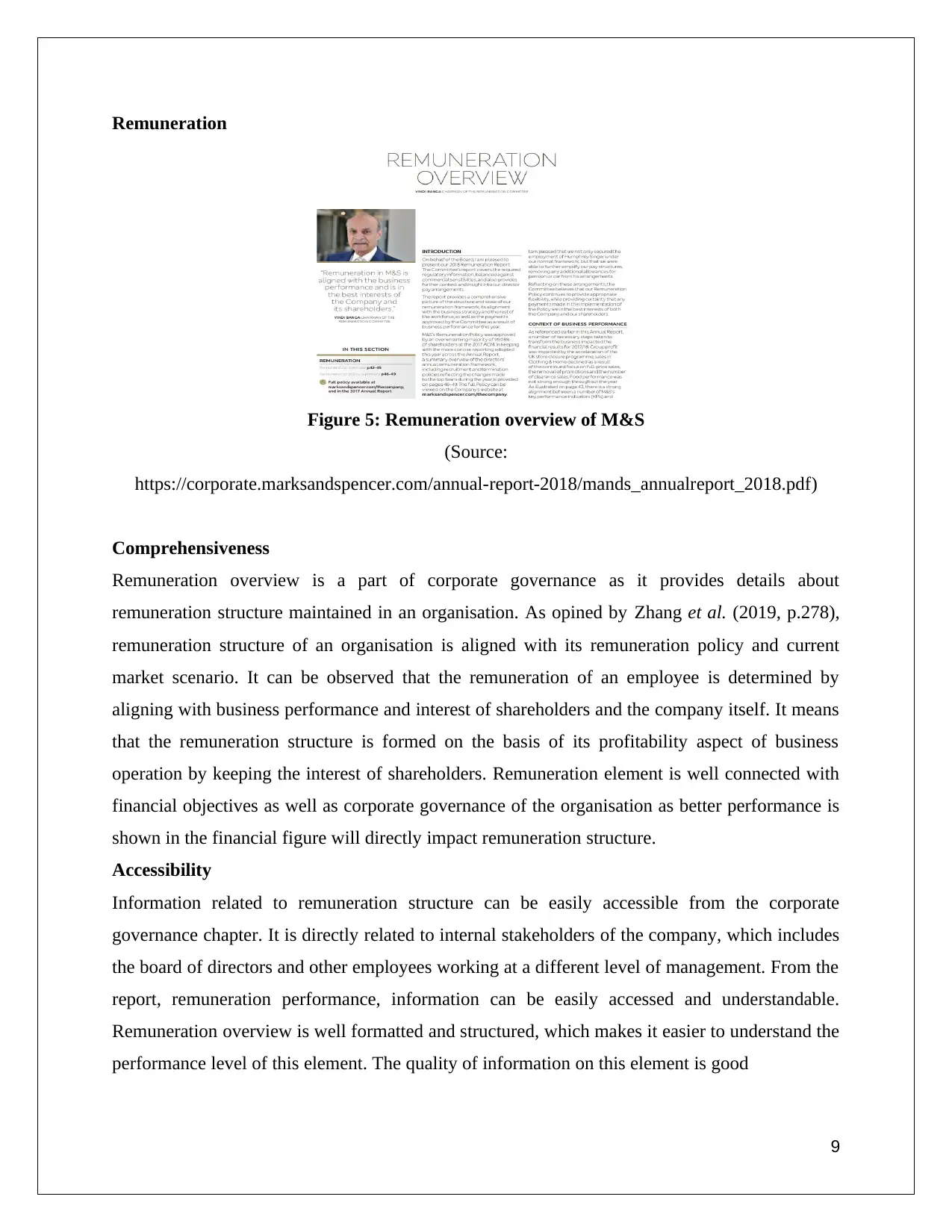
Remuneration
Figure 5: Remuneration overview of M&S
(Source:
https://corporate.marksandspencer.com/annual-report-2018/mands_annualreport_2018.pdf)
Comprehensiveness
Remuneration overview is a part of corporate governance as it provides details about
remuneration structure maintained in an organisation. As opined by Zhang et al. (2019, p.278),
remuneration structure of an organisation is aligned with its remuneration policy and current
market scenario. It can be observed that the remuneration of an employee is determined by
aligning with business performance and interest of shareholders and the company itself. It means
that the remuneration structure is formed on the basis of its profitability aspect of business
operation by keeping the interest of shareholders. Remuneration element is well connected with
financial objectives as well as corporate governance of the organisation as better performance is
shown in the financial figure will directly impact remuneration structure.
Accessibility
Information related to remuneration structure can be easily accessible from the corporate
governance chapter. It is directly related to internal stakeholders of the company, which includes
the board of directors and other employees working at a different level of management. From the
report, remuneration performance, information can be easily accessed and understandable.
Remuneration overview is well formatted and structured, which makes it easier to understand the
performance level of this element. The quality of information on this element is good
9
Figure 5: Remuneration overview of M&S
(Source:
https://corporate.marksandspencer.com/annual-report-2018/mands_annualreport_2018.pdf)
Comprehensiveness
Remuneration overview is a part of corporate governance as it provides details about
remuneration structure maintained in an organisation. As opined by Zhang et al. (2019, p.278),
remuneration structure of an organisation is aligned with its remuneration policy and current
market scenario. It can be observed that the remuneration of an employee is determined by
aligning with business performance and interest of shareholders and the company itself. It means
that the remuneration structure is formed on the basis of its profitability aspect of business
operation by keeping the interest of shareholders. Remuneration element is well connected with
financial objectives as well as corporate governance of the organisation as better performance is
shown in the financial figure will directly impact remuneration structure.
Accessibility
Information related to remuneration structure can be easily accessible from the corporate
governance chapter. It is directly related to internal stakeholders of the company, which includes
the board of directors and other employees working at a different level of management. From the
report, remuneration performance, information can be easily accessed and understandable.
Remuneration overview is well formatted and structured, which makes it easier to understand the
performance level of this element. The quality of information on this element is good
9
⊘ This is a preview!⊘
Do you want full access?
Subscribe today to unlock all pages.

Trusted by 1+ million students worldwide
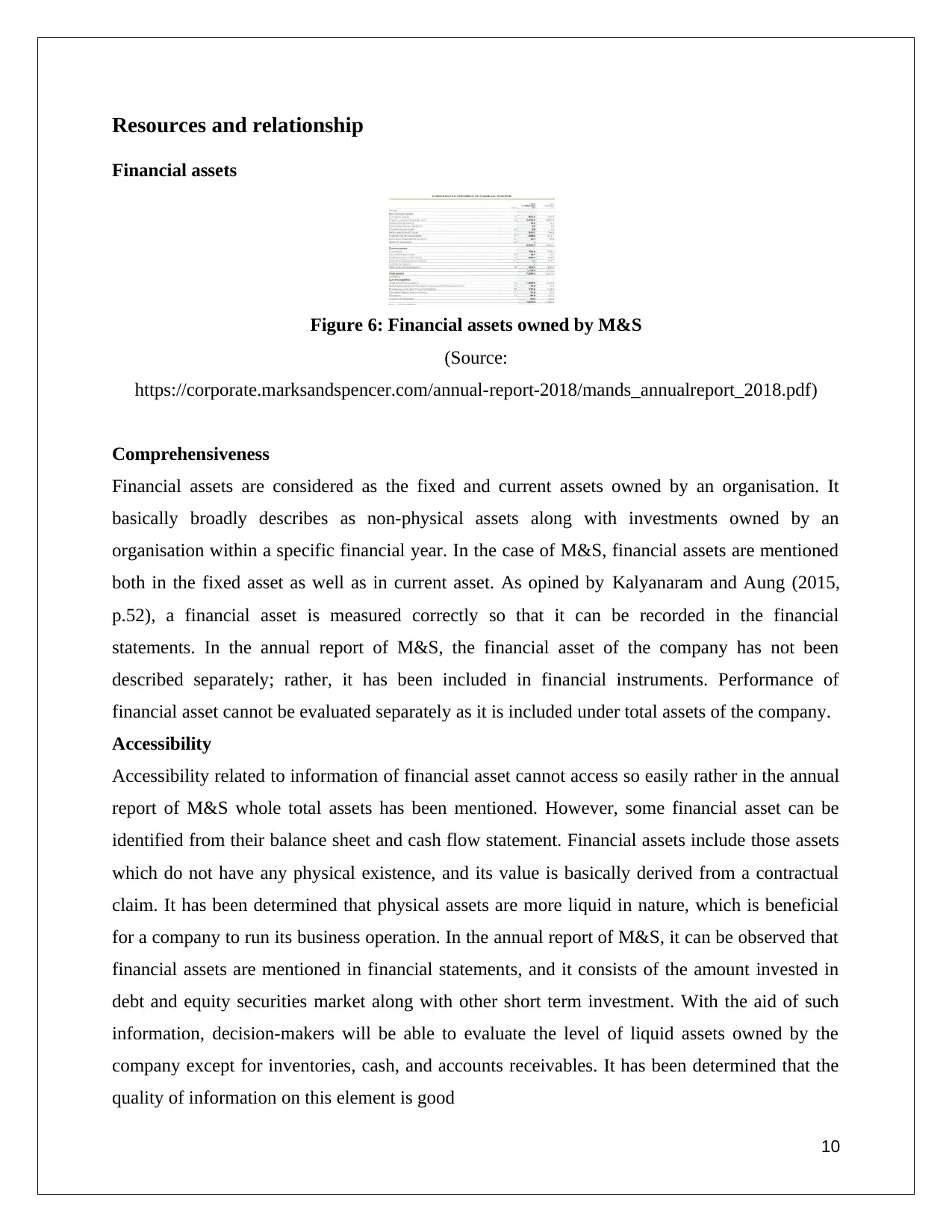
Resources and relationship
Financial assets
Figure 6: Financial assets owned by M&S
(Source:
https://corporate.marksandspencer.com/annual-report-2018/mands_annualreport_2018.pdf)
Comprehensiveness
Financial assets are considered as the fixed and current assets owned by an organisation. It
basically broadly describes as non-physical assets along with investments owned by an
organisation within a specific financial year. In the case of M&S, financial assets are mentioned
both in the fixed asset as well as in current asset. As opined by Kalyanaram and Aung (2015,
p.52), a financial asset is measured correctly so that it can be recorded in the financial
statements. In the annual report of M&S, the financial asset of the company has not been
described separately; rather, it has been included in financial instruments. Performance of
financial asset cannot be evaluated separately as it is included under total assets of the company.
Accessibility
Accessibility related to information of financial asset cannot access so easily rather in the annual
report of M&S whole total assets has been mentioned. However, some financial asset can be
identified from their balance sheet and cash flow statement. Financial assets include those assets
which do not have any physical existence, and its value is basically derived from a contractual
claim. It has been determined that physical assets are more liquid in nature, which is beneficial
for a company to run its business operation. In the annual report of M&S, it can be observed that
financial assets are mentioned in financial statements, and it consists of the amount invested in
debt and equity securities market along with other short term investment. With the aid of such
information, decision-makers will be able to evaluate the level of liquid assets owned by the
company except for inventories, cash, and accounts receivables. It has been determined that the
quality of information on this element is good
10
Financial assets
Figure 6: Financial assets owned by M&S
(Source:
https://corporate.marksandspencer.com/annual-report-2018/mands_annualreport_2018.pdf)
Comprehensiveness
Financial assets are considered as the fixed and current assets owned by an organisation. It
basically broadly describes as non-physical assets along with investments owned by an
organisation within a specific financial year. In the case of M&S, financial assets are mentioned
both in the fixed asset as well as in current asset. As opined by Kalyanaram and Aung (2015,
p.52), a financial asset is measured correctly so that it can be recorded in the financial
statements. In the annual report of M&S, the financial asset of the company has not been
described separately; rather, it has been included in financial instruments. Performance of
financial asset cannot be evaluated separately as it is included under total assets of the company.
Accessibility
Accessibility related to information of financial asset cannot access so easily rather in the annual
report of M&S whole total assets has been mentioned. However, some financial asset can be
identified from their balance sheet and cash flow statement. Financial assets include those assets
which do not have any physical existence, and its value is basically derived from a contractual
claim. It has been determined that physical assets are more liquid in nature, which is beneficial
for a company to run its business operation. In the annual report of M&S, it can be observed that
financial assets are mentioned in financial statements, and it consists of the amount invested in
debt and equity securities market along with other short term investment. With the aid of such
information, decision-makers will be able to evaluate the level of liquid assets owned by the
company except for inventories, cash, and accounts receivables. It has been determined that the
quality of information on this element is good
10
Paraphrase This Document
Need a fresh take? Get an instant paraphrase of this document with our AI Paraphraser
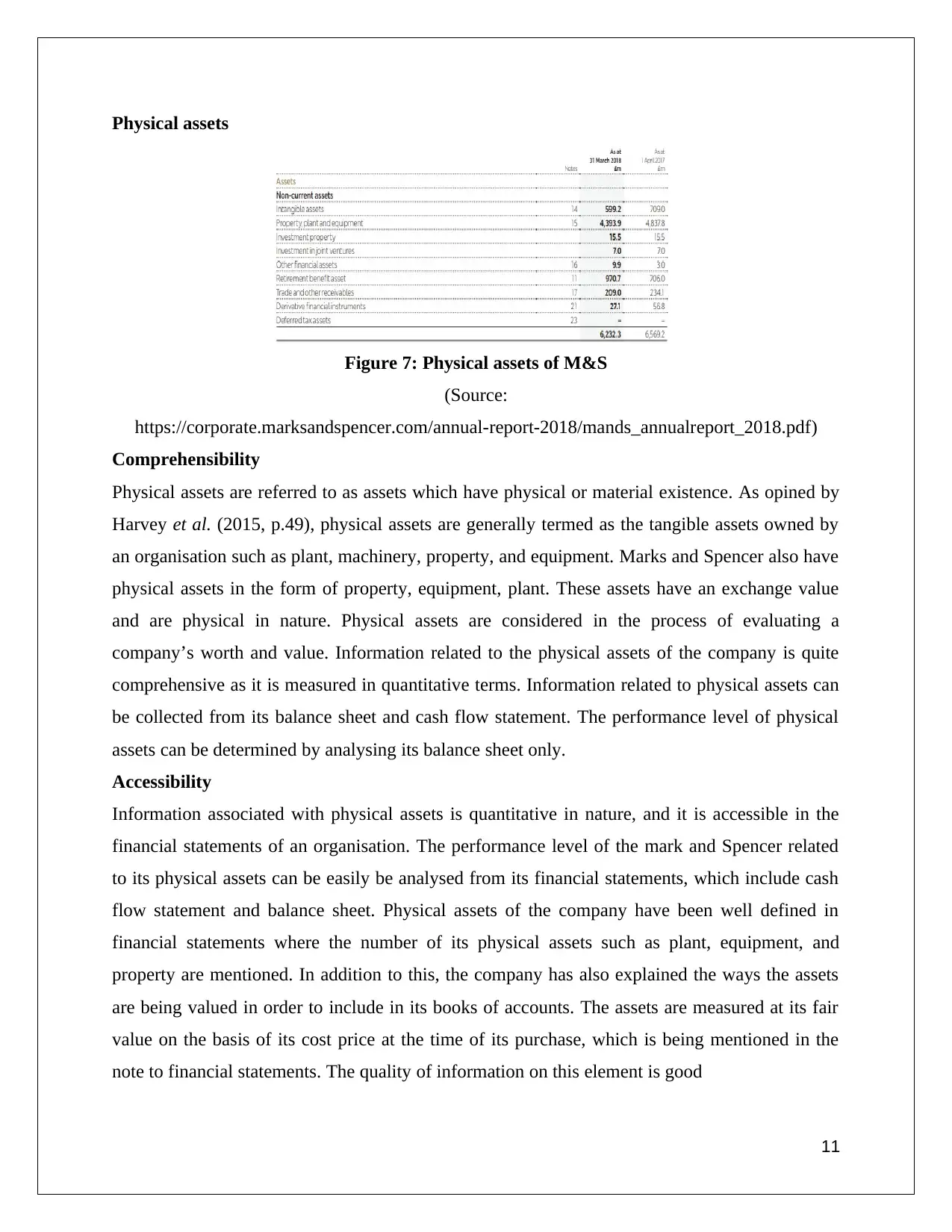
Physical assets
Figure 7: Physical assets of M&S
(Source:
https://corporate.marksandspencer.com/annual-report-2018/mands_annualreport_2018.pdf)
Comprehensibility
Physical assets are referred to as assets which have physical or material existence. As opined by
Harvey et al. (2015, p.49), physical assets are generally termed as the tangible assets owned by
an organisation such as plant, machinery, property, and equipment. Marks and Spencer also have
physical assets in the form of property, equipment, plant. These assets have an exchange value
and are physical in nature. Physical assets are considered in the process of evaluating a
company’s worth and value. Information related to the physical assets of the company is quite
comprehensive as it is measured in quantitative terms. Information related to physical assets can
be collected from its balance sheet and cash flow statement. The performance level of physical
assets can be determined by analysing its balance sheet only.
Accessibility
Information associated with physical assets is quantitative in nature, and it is accessible in the
financial statements of an organisation. The performance level of the mark and Spencer related
to its physical assets can be easily be analysed from its financial statements, which include cash
flow statement and balance sheet. Physical assets of the company have been well defined in
financial statements where the number of its physical assets such as plant, equipment, and
property are mentioned. In addition to this, the company has also explained the ways the assets
are being valued in order to include in its books of accounts. The assets are measured at its fair
value on the basis of its cost price at the time of its purchase, which is being mentioned in the
note to financial statements. The quality of information on this element is good
11
Figure 7: Physical assets of M&S
(Source:
https://corporate.marksandspencer.com/annual-report-2018/mands_annualreport_2018.pdf)
Comprehensibility
Physical assets are referred to as assets which have physical or material existence. As opined by
Harvey et al. (2015, p.49), physical assets are generally termed as the tangible assets owned by
an organisation such as plant, machinery, property, and equipment. Marks and Spencer also have
physical assets in the form of property, equipment, plant. These assets have an exchange value
and are physical in nature. Physical assets are considered in the process of evaluating a
company’s worth and value. Information related to the physical assets of the company is quite
comprehensive as it is measured in quantitative terms. Information related to physical assets can
be collected from its balance sheet and cash flow statement. The performance level of physical
assets can be determined by analysing its balance sheet only.
Accessibility
Information associated with physical assets is quantitative in nature, and it is accessible in the
financial statements of an organisation. The performance level of the mark and Spencer related
to its physical assets can be easily be analysed from its financial statements, which include cash
flow statement and balance sheet. Physical assets of the company have been well defined in
financial statements where the number of its physical assets such as plant, equipment, and
property are mentioned. In addition to this, the company has also explained the ways the assets
are being valued in order to include in its books of accounts. The assets are measured at its fair
value on the basis of its cost price at the time of its purchase, which is being mentioned in the
note to financial statements. The quality of information on this element is good
11
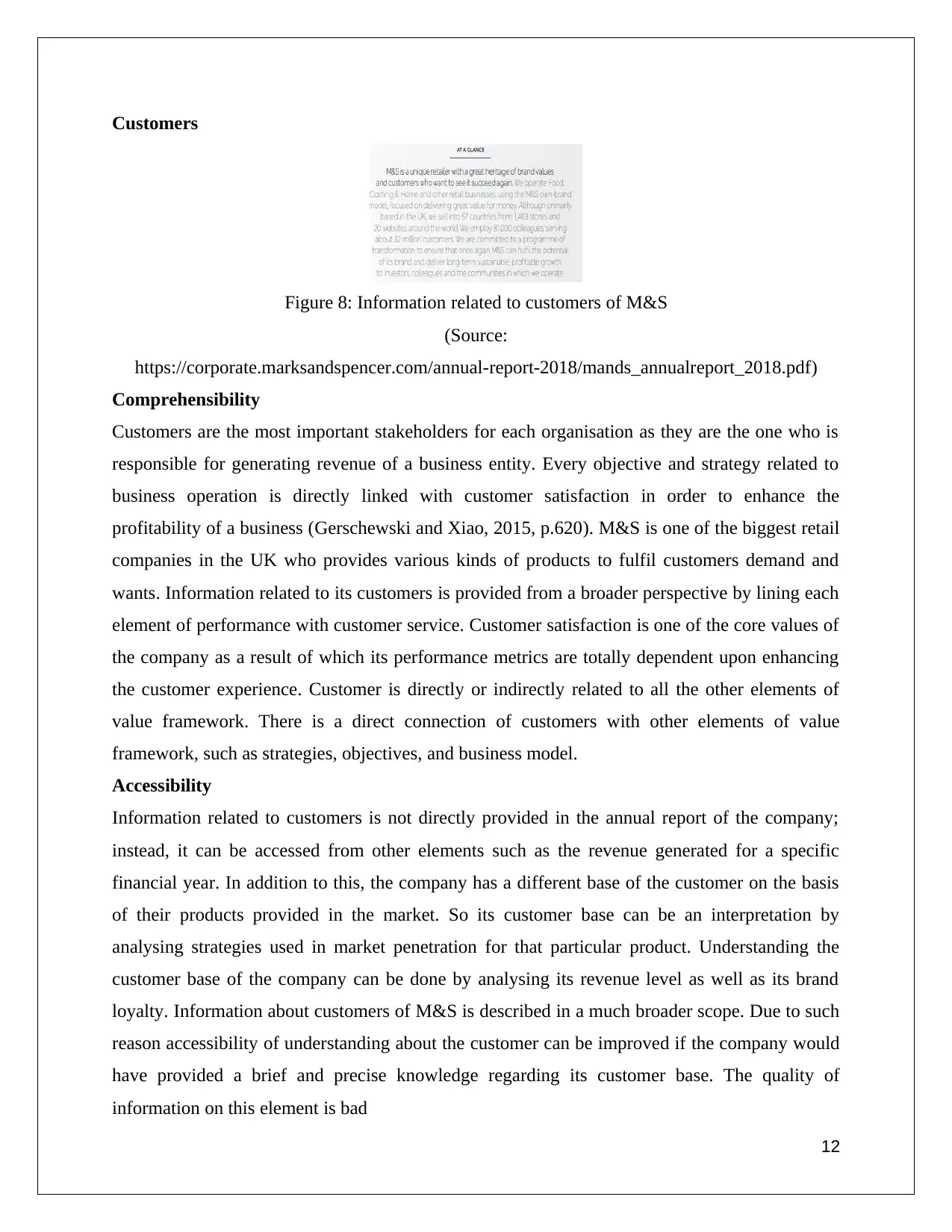
Customers
Figure 8: Information related to customers of M&S
(Source:
https://corporate.marksandspencer.com/annual-report-2018/mands_annualreport_2018.pdf)
Comprehensibility
Customers are the most important stakeholders for each organisation as they are the one who is
responsible for generating revenue of a business entity. Every objective and strategy related to
business operation is directly linked with customer satisfaction in order to enhance the
profitability of a business (Gerschewski and Xiao, 2015, p.620). M&S is one of the biggest retail
companies in the UK who provides various kinds of products to fulfil customers demand and
wants. Information related to its customers is provided from a broader perspective by lining each
element of performance with customer service. Customer satisfaction is one of the core values of
the company as a result of which its performance metrics are totally dependent upon enhancing
the customer experience. Customer is directly or indirectly related to all the other elements of
value framework. There is a direct connection of customers with other elements of value
framework, such as strategies, objectives, and business model.
Accessibility
Information related to customers is not directly provided in the annual report of the company;
instead, it can be accessed from other elements such as the revenue generated for a specific
financial year. In addition to this, the company has a different base of the customer on the basis
of their products provided in the market. So its customer base can be an interpretation by
analysing strategies used in market penetration for that particular product. Understanding the
customer base of the company can be done by analysing its revenue level as well as its brand
loyalty. Information about customers of M&S is described in a much broader scope. Due to such
reason accessibility of understanding about the customer can be improved if the company would
have provided a brief and precise knowledge regarding its customer base. The quality of
information on this element is bad
12
Figure 8: Information related to customers of M&S
(Source:
https://corporate.marksandspencer.com/annual-report-2018/mands_annualreport_2018.pdf)
Comprehensibility
Customers are the most important stakeholders for each organisation as they are the one who is
responsible for generating revenue of a business entity. Every objective and strategy related to
business operation is directly linked with customer satisfaction in order to enhance the
profitability of a business (Gerschewski and Xiao, 2015, p.620). M&S is one of the biggest retail
companies in the UK who provides various kinds of products to fulfil customers demand and
wants. Information related to its customers is provided from a broader perspective by lining each
element of performance with customer service. Customer satisfaction is one of the core values of
the company as a result of which its performance metrics are totally dependent upon enhancing
the customer experience. Customer is directly or indirectly related to all the other elements of
value framework. There is a direct connection of customers with other elements of value
framework, such as strategies, objectives, and business model.
Accessibility
Information related to customers is not directly provided in the annual report of the company;
instead, it can be accessed from other elements such as the revenue generated for a specific
financial year. In addition to this, the company has a different base of the customer on the basis
of their products provided in the market. So its customer base can be an interpretation by
analysing strategies used in market penetration for that particular product. Understanding the
customer base of the company can be done by analysing its revenue level as well as its brand
loyalty. Information about customers of M&S is described in a much broader scope. Due to such
reason accessibility of understanding about the customer can be improved if the company would
have provided a brief and precise knowledge regarding its customer base. The quality of
information on this element is bad
12
⊘ This is a preview!⊘
Do you want full access?
Subscribe today to unlock all pages.

Trusted by 1+ million students worldwide
1 out of 26
Related Documents
Your All-in-One AI-Powered Toolkit for Academic Success.
+13062052269
info@desklib.com
Available 24*7 on WhatsApp / Email
![[object Object]](/_next/static/media/star-bottom.7253800d.svg)
Unlock your academic potential
Copyright © 2020–2025 A2Z Services. All Rights Reserved. Developed and managed by ZUCOL.





